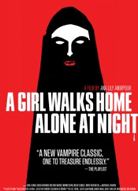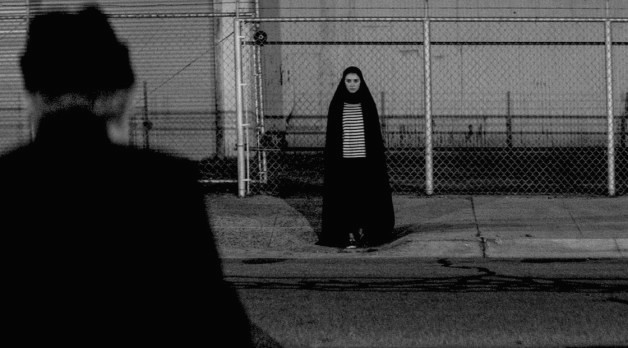 Let's be honest: as of 2014, the vampire sucked. Over its 150+ year history, the vampire has evolved from the exotic, erotic monster of Le Fanu's Carmilla and Stoker's Dracula, to Lugosi's low budget lothario, to the dangerously sexy rebels of The Lost Boys, to the brooding romantics of Anne Rice and Joss Whedon, to the defanged teenage fantasies of American preteen girls.While I don't begrudge girls their sexual fantasies, the fact remains that the vampire, in its current glittery form, is a far cry from the symbol of sexuality and otherness that it had been at its inception. With notable exceptions like Thirst and Let the Right One In, vampires have spent the last 30 years getting weaker, whiter, more often male, and very American. With A Girl Walks Home Alone at Night, Iranian American writer/director Ana Lily Amirpour is here to change all that.
Let's be honest: as of 2014, the vampire sucked. Over its 150+ year history, the vampire has evolved from the exotic, erotic monster of Le Fanu's Carmilla and Stoker's Dracula, to Lugosi's low budget lothario, to the dangerously sexy rebels of The Lost Boys, to the brooding romantics of Anne Rice and Joss Whedon, to the defanged teenage fantasies of American preteen girls.While I don't begrudge girls their sexual fantasies, the fact remains that the vampire, in its current glittery form, is a far cry from the symbol of sexuality and otherness that it had been at its inception. With notable exceptions like Thirst and Let the Right One In, vampires have spent the last 30 years getting weaker, whiter, more often male, and very American. With A Girl Walks Home Alone at Night, Iranian American writer/director Ana Lily Amirpour is here to change all that.
It's difficult to define A Girl Walks Home Alone At Night as just one movie: it's a vampire flick, a spaghetti western, a love story, a feminist fantasy, and an allegory about Iran. The plot is fairly simple to describe: a young man named Arash (Arash Marandi) living in a corrupt city in Iran (known only as Bad City) falls in love with The Girl (Sheila Vand), a streetwalking vampire who preys on drugdealers and beggars. But don't dismiss this as a weak narrative film.
It's also a movie of gorgeous images: beautiful noir-esque black and white cinematography and striking visual non-sequiturs abound. bell hooks once stated that dominant structures reinforce dominant ideologies, but Ana Lily Amirpour's film bites into disenfranchisement through style and structure.
The most prominent example of how Amirpour likes to play with conventional expectations is the vampire, The Girl. Dressed in a chador and a white-and-black striped shirt, The Girl at first appears as a striking, shadowy figure of feminist revenge who murders a misogynist drug dealer. But lest she seem like the hero, The Girl's other victims aren't nearly so deserving. But lest she seem a monster, here's a scene of The Girl riding a skateboard, chador flapping behind her in the wind. The Girl is a slippery symbol, but she's not the only vampire in the film: there's also the drug dealer sucking Arash's father dry, the oil wells sucking the city dry, dominant forces that leach resources from the community. The Girl, though the only real vampire in the film, is nonetheless more human than the larger monsters that loom over the community.
Likewise, Amirpour's decision to reference spaghetti westerns throughout brings up the question of morality. In the western genre, even spaghetti westerns, there is always a clear hero and villain. However, nobody in the film could stand in for a hero, and the most obvious villain of A Girl Walks Home Alone At Night dies fairly quickly. This leaves a sizable hole where the genre tropes should be. With no gunman's showdown or even a tangible villain to fight, the film's characters mostly wander, left to struggle for their own survival.

Throughout A Girl Walks Home Alone At Night, Ana Lily Amirpour sets up genre conventions with the intent of knocking them down. The result is a beautiful, unusual film, a mishmash of cultures. Despite its Iranian language, A Girl Walks Home Alone At Night was actually shot in Bakersfield, CA, adding to its spaghetti western authenticity. Nonetheless, it captures a version of Iran that Amirpour sees: corrupt, violent, and destructive. From a symbol of sex and danger, Amirpour turns the vampire into a symbol of corruption. So which is scarier, the monster you can see, or the monster in the system?

 This month on Women's Pictures we've been celebrating Halloween with Women Directors. Previously: Near Dark, Ravenous, and American Psycho
This month on Women's Pictures we've been celebrating Halloween with Women Directors. Previously: Near Dark, Ravenous, and American Psycho
10/29 The Babadook (2014) - If it's in a word, or in a look, you can't escape from first-time feature director Jennifer Kent's The Babadook. (Amazon) (Netflix)
